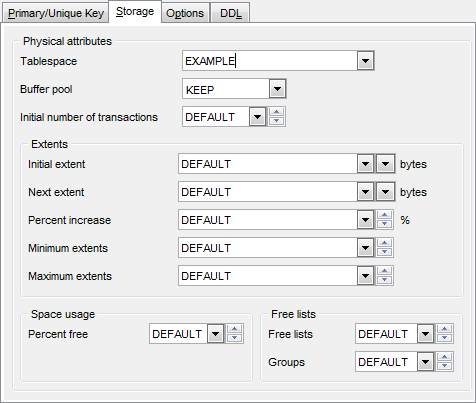Online Documentation for SQL Manager for Oracle
Storage options
The Physical Attributes / Storage tab available in object editors lets you specify how a database object should be stored in the database. Storage parameters affect both how long it takes to access data stored in the database and how efficiently space in the database is used.

Physical attributes
Tablespace
Use the drop-down list to select the tablespace where the object will be stored.
Buffer pool
This option allows you to specify a default buffer pool or cache for the object. All blocks for the object are stored in the specified cache. Use the drop-down list to select one of the following values:
KEEP: the buffer pool retains the schema object's data blocks in memory;
RECYCLE: the buffer pool eliminates data blocks from memory as soon as they are no longer needed.
DEFAULT: the buffer pool contains data blocks from schema objects that are not assigned to any buffer pool, as well as schema objects that are explicitly assigned to the DEFAULT pool.
Initial number of transactions
Specify the initial number of concurrent transaction entries allocated within each data block allocated to the database object, or select DEFAULT from the drop-down list.
Extents
An extent is a logical unit of database storage space allocation made up of a number of contiguous data blocks. One or more extents in turn make up a segment. When the existing space in a segment is completely used, Oracle allocates a new extent for the segment.
Initial extent
Specify the size (in bytes) of the first extent of the object. Oracle allocates space for this extent when you create the schema object, or select DEFAULT from the drop-down list.
Next extent
Specify the size (in bytes) of the next extent to be allocated to the object, or select DEFAULT from the drop-down list.
Percent increase
Specify the percent by which the third and subsequent extents grow over the preceding extent, or select DEFAULT from the drop-down list (the default value is 50, meaning that each subsequent extent is 50 per cent larger than the preceding extent)
Minimum extents
Specify the total number of extents to allocate when the object is created, or select DEFAULT from the drop-down list. This parameter lets you allocate a large amount of space when you create an object, even if the space available is not contiguous.
Maximum extents
Specify the total number of extents, including the first, that Oracle can allocate for the object, or select DEFAULT or UNLIMITED from the drop-down list.
Space usage
Parameters of this group allow you to control the use of free space for inserts and updates to the rows in all the data blocks of a particular segment.
Percent free
This parameter sets the minimum percentage of a data block to be reserved as free space for possible updates to rows that already exist in that block. Specify a value, or select DEFAULT from the drop-down list.
Free lists
Free lists
Specify the number of free lists that can be contained in each free list group, or select DEFAULT from the drop-down list (the default and minimum value for this parameter is 1, meaning that each free list group contains one free list).
Groups
Specify the number of groups of free lists for the database object being created, or select DEFAULT from the drop-down list (the default and minimum value for this parameter is 1).



































































